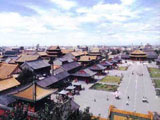 Shenyang is the capital of Liaoning Province in northeast China. It?s not only an important industrial base, but also a famous historical city, home to the country?s second largest imperial palace complex.
Shenyang is the capital of Liaoning Province in northeast China. It?s not only an important industrial base, but also a famous historical city, home to the country?s second largest imperial palace complex.
Shenyang is the largest city in northeast China and one of the country?s major industrial centers. But with a history of over 2,000 years, it is also a well-known historical and cultural city, renowned for its spectacular ancient architecture and abundant cultural relics.
China has two remaining well-preserved imperial palace complexes. One is the world-famous Forbidden City in Beijing. The other is in Shenyang; this palace is as historically and artistically valuable as the Forbidden City, although it is less well known.
The Shenyang Imperial Palace was the former residence of Nurhachi and his son Huangtaiji, the first two emperors of the Qing Dynasty established by the Manchu ethnic group in the mid-17th century.
Before the Manchus came to dominate the whole country, they lived mainly in the northeastern part of the country. In the late 16th century, Nurhachi, a tribal leader of the Manchus, united all the tribes of this nomadic ethnic group and founded the Houjin Kingdom, the predecessor of China?s last feudal dynasty, the Qing dynasty. He designated Shenyang as his capital and had a magnificent palace built here to rival the Forbidden City in Beijing.
Construction of this imperial palace started in 1625 and was completed a decade later. The palace closely resembles the Forbidden City in its layout, but it?s smaller in scale and distinctive for its Manchu style architecture, which is a blend of Han and Mongolian influences.
The complex covers an area of 60 thousand square meters and has about 100 buildings dispersed in some 20 courtyards. The buildings are all richly ornamented, with carved beams and beautifully painted rafters and ceilings.
The complex is divided into three sections. The middle section is the major part. It starts at the Daqing Gate. To its north is the grand Hall of Supreme Administration, where Huangtaiji conducted state affairs and met leaders of other ethnic groups. Behind it stand the Phoenix Tower and several residential palaces for Huangtaiji and his concubines.
The eastern section is where Huangtaiji?s father, Nurhachi lived and handled political affairs. The buildings on the west side include a library, a theater, a study tower and some smaller halls.
Today, part of the imperial palace is a museum with a wide variety of Manchu artifacts on display. They help visitors to appreciate the stories about the early days of China?s last feudal dynasty.
The founding fathers of the Qing Dynasty, Nurhachi and Huangtaiji, are regarded as great heroes of the Manchu ethnic group. Their mausoleums in the suburbs of Shenyang are one of the city?s biggest tourist attractions.
The Eastern Tomb is the burial place of Nurhachi and his wife, while the Northern Tomb is that of Huangtaiji and his wife. The paths in the burial grounds are lined with a large number of stone statues of horses, lions, tigers and camels. For Chinese people believing in life after death, these animals were seen as protectors in the afterworld.
Strolling through the mausoleum grounds, you?ll be delighted by the many exquisite archways, stone tablets, pavilions, towers and halls. The magnificent buildings and ancient pine and cypress trees set each other off, giving one a strong feeling of stateliness, solemnity and tranquility.
As the early capital of the Qing Dynasty, Shenyang is also home to many other historic sites, such as towers, pagodas, temples and palaces, all telling the ancient stories of the Manchu ethnic group.
If you are a history buff, you?ll find Shenyang a fascinating place, but the city is by no means disappointing to those who enjoy the beauty of nature. Its many scenic attractions, such as Qipan Mountain, Wolong Lake, the Botanical Gardens and Ludao Forest Park, all guarantee a wonderful time.
The provincial capital is now the largest communications hub in northeast China. It has convenient transport links with many cities across the country, as well as with Russia, Japan and the Korean Peninsula. And it?s very easy for you to find hotels to suit any budget.
(CRI February 19, 2003)
|

